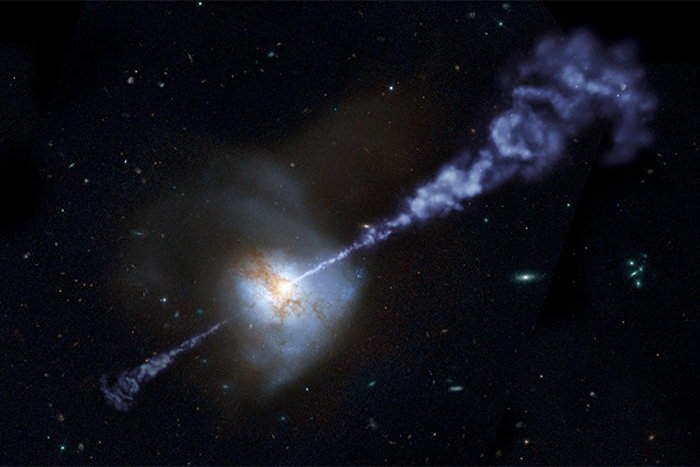Mystery Fast Radio Burst Caused By Flashing Black Hole

The true nature of mysterious fast radio bursts (FRBs) may not have been revealed after all.
These energetic eruptions seem to pop up in random locations in the cosmos and they appear and disappear in a matter of milliseconds, making them exceedingly hard to pinpoint. Until February, only a handful of definitive FRB signals had been uncovered in archival radio data. As these signals were recorded months or years in the past, follow-up observations were all but impossible, leaving the source of these flashes steeped in mystery.
Top 10 Astronomical Discoveries Of All Time
But that was until the Australian 64-meter Parkes Radio Telescope got lucky and spotted an FRB erupt. Immediately, a collaboration of international astronomers were notified and other observatories slewed into the direction of the burst, zooming-in on its radio afterglow. The Japanese Subaru telescope on Mauna Kea in Hawaii was then able to zero-in on the burst's location and identify a galaxy as the source.
Very quickly the collaboration made some conclusions based on the information they could gather from the source. The galaxy was an old elliptical located around 6 billion light-years from Earth. This galaxy shows little sign of star formation, so it was pretty clear that FRBs (at least in this isolated case) probably aren't related to star formation processes.
The FRB signal, dubbed "FRB 150418," was even used to test some of our models of the cosmos — through the analysis of the signal and knowing where it had some from, astrophysicists were able to measure the cosmic expansion and the quantity of dark matter the radio emission traveled through.
ANALYSIS: Mysterious 'Fast Radio Burst' Pinpointed for First Time
Get the Space.com Newsletter
Breaking space news, the latest updates on rocket launches, skywatching events and more!
Although much hope was pinned on the February event being evidence of a new cosmic phenomenon, concerns from the astronomical community quickly surfaced: Was FRB 150418 really an FRB? Or was it a known phenomenon masquerading as the mysterious pulse?
In a new study accepted for publication in the Astrophysical Journal Letters, Harvard astronomers Peter Williams and Edo Berger think that this particular signal was actually a case of mistaken identity and the real source of FRBs remains a mystery.
Using the NSF's Jansky Very Large Array in New Mexico, Williams and Berger was able to gather radio data from the suspect galaxy that produced FRB 150418 and they detected even more radio pulses. FRBs are thought to be one-shot deals; they flash, generating a huge energy output for a few milliseconds and then they disappear. This galaxy, however, was still generating flashes of radio emissions, some as powerful as the measurements of FRB 150418's radio afterglow.
"What the other team saw was nothing unusual," said Berger in a statement. "The radio emission from this source goes up and down, but it never goes away. That means it can't be associated with the fast radio burst."
ANALYSIS: Not So Fast: Radio Burst Mystery Far From Solved
So what could be causing such a signal? Well, supermassive black holes in the centers of active galactic nuclei are constantly throbbing with radio emissions. Matter inside the galactic bulge, such as stars, dust and gas, get trapped in the black hole's gravitational well, forming a hot accretion disk. In addition, these black hole monsters constantly erupt with powerful jets of relativistic matter ejected from the black hole's poles. These mechanisms produce a lot of radio waves.
Over the vast distance between this galaxy and Earth, interstellar gases will cause the radio waves to scintillate — in other words, the steady radio signal will appear to flicker from afar. And this is probably what was detected in February: a flickering radio signal from a supermassive black hole and not an FRB.
So it looks like the mystery origin of FRBs is just as mysterious as it was in 2007, when the first FRB was found in archival data. "We don't even know if they come from inside our galaxy or if they're extragalactic," said Berger, pointing out that we are currently on the trail of a puzzle just as strange as gamma-ray burst mystery was 30 years ago.
Source: CfA
Originally published on Discovery News.
Join our Space Forums to keep talking space on the latest missions, night sky and more! And if you have a news tip, correction or comment, let us know at: community@space.com.
Ian O'Neill is a media relations specialist at NASA's Jet Propulsion Laboratory (JPL) in Southern California. Prior to joining JPL, he served as editor for the Astronomical Society of the Pacific‘s Mercury magazine and Mercury Online and contributed articles to a number of other publications, including Space.com, Space.com, Live Science, HISTORY.com, Scientific American. Ian holds a Ph.D in solar physics and a master's degree in planetary and space physics.









